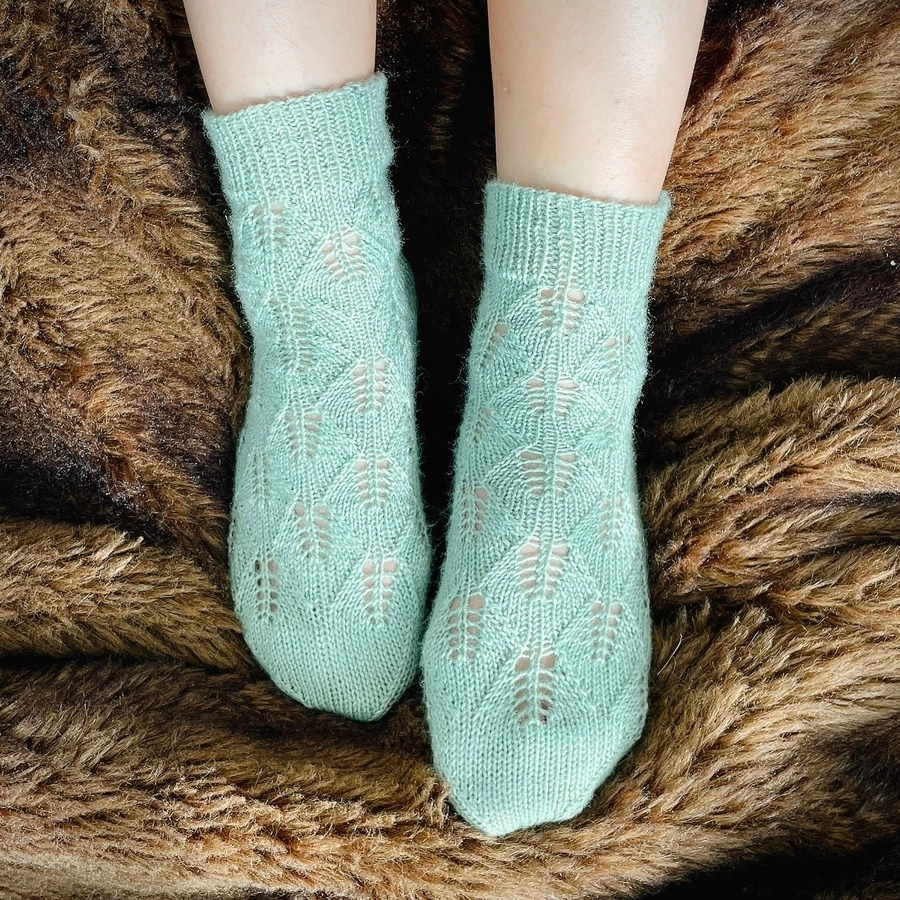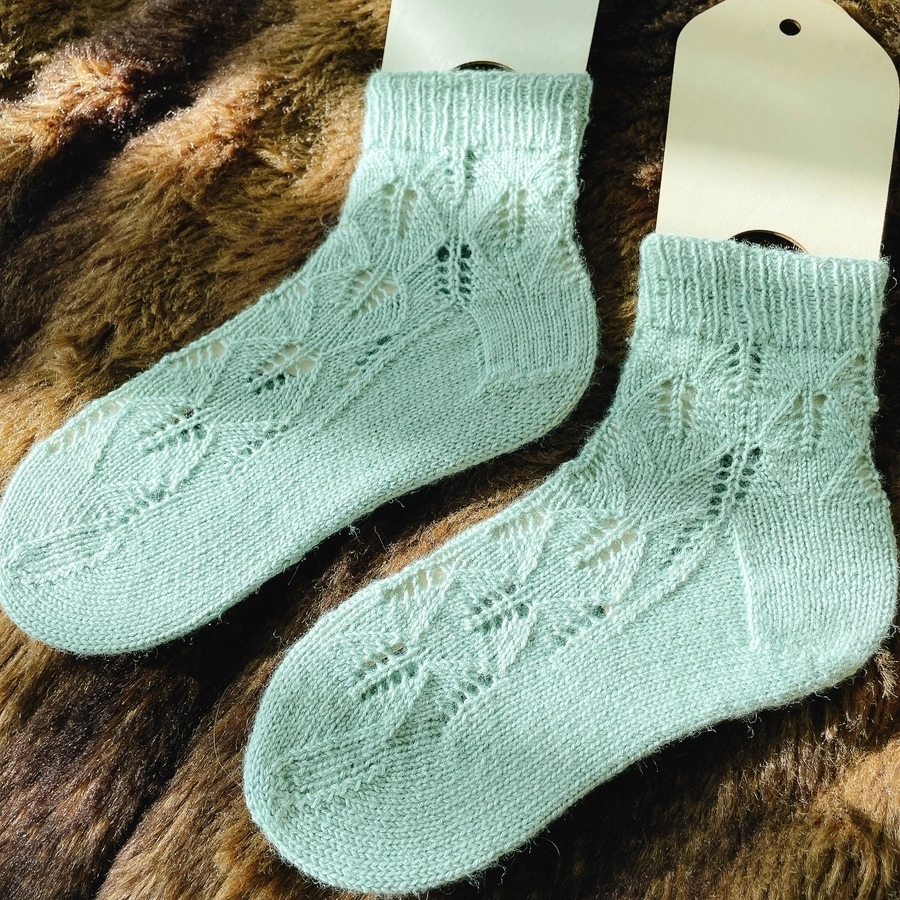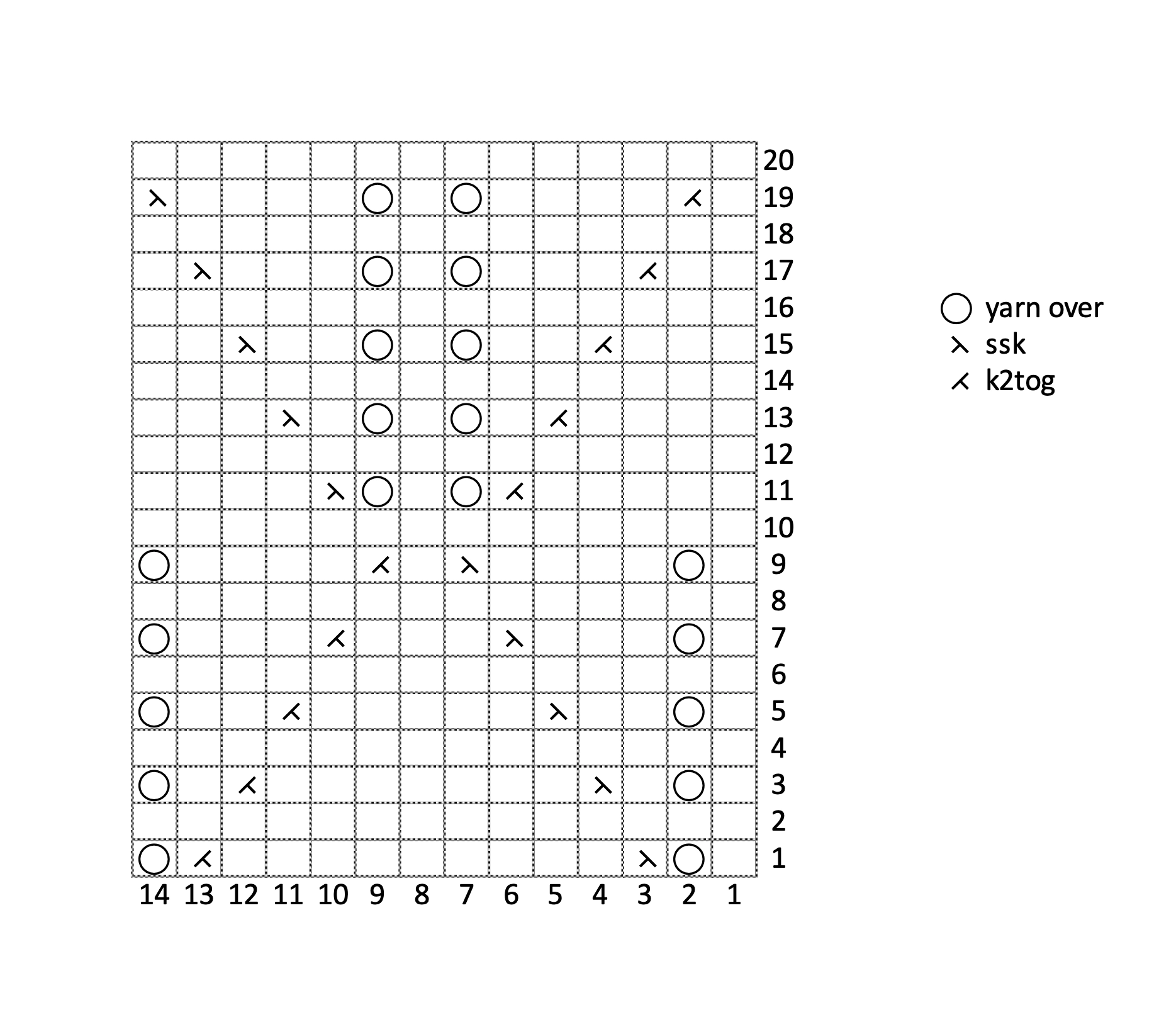Lace Leaves Cuff-down Socks
February 21, 2025

The lace leaves chart comes from a japanese stitch book but I couldn’t remember the exact source. I incorporated the lace into my go-to cuff-down socks recipe, and it came out beautifully with the light fingering weight yarn.
Walk-through
I usually cast on 64 sts for light fingering weight socks, but the Jawoll Silk yarn is thicker than the sock yarn I worked before, so I figured I should change the CO number. The most important factor is the lace pattern, which is a 14x20 repeat. To preserve the lace pattern, I eventually cast on 56 sts to make a complete 4 times lace repeat. For the cuff itself, I used simple 1x1 rib.
The leg, as I mentioned, is a 4 times lace repeat. The length is a personal choice - I prefer ankle socks, so I stopped at 2’’ when I was halfway through the second repeat, which makes 30 rows (20+10) for the leg.
For the heel flap, I used this sock calculator to calculate the stitches because I can never remember it even though I’ve done it multiple times. Once I completed the heel and picked up the gusset, I continued the lace pattern on the instep and knit the back in plain stockinette, until the pattern completed the repeats and reached the desired length. For me, that was exactly 3 chart repeats. On my first sock, I made the mistake of not remembering where I stopped the lace before the heel, resulting in one lace repeat looking off, but it’s too late to fix when I noticed it.
One technique I tried in this sock pattern is to use alternative SSK instead of regular SSK for the decrease. The alternative SSK definitely looks neater and more symmetrical to the k2tog side.
As for the knitting supplies, I knitted with a US 2 needles for the whole sock, including the rib and body. A smaller needle for the rib would make it more fitted, but I prefer a looser fit at the ankle. And the yarn - I’m in love with the Jawoll Silk yarn! The colourway is a subtle, pastel sage colour. A light colour yarn like this makes the lace stand out and showcase its beauty, and looks summer-ish! It feels so soft and is easy to work with. It’s also superwash so I can throw it in the laundry without worrying too much. The material is a wool/nylon/silk blend, which to me is a perfect summer sock combo. The yarn weight, as I mentioned, is slightly thicker than the sock yarns I usually work with but still has a delicate look. I wish I had bought more - I got the yarn at a Vancouver LYS called West Coast wool, and now I found that it’s very hard to find them at my LYS.
I completed the majority of the sock while commuting to my kendo classes, and it took about two months to finish the project. While I love knitting socks during my commute, this was my first time using DPN on the public transportation, and I wasn’t a big fan of it. I was constantly worried about dropping the needles (which happened a few times) and the possibility of losing one forever made me anxious. So I guess I’ll be back to the magic loop club for my next commute knitting project. Yay!

Pattern
Material
- Yarn: 1 x Lang Yarns Jawoll Silk (192 Salbei)
- Needle: US 2 DPN
- Darning needles
- Stitch markers
Size
The instructions are based on women size US 6.5. You can customize the sock size using this sock calcuator. Remember to make the total stitches number is a multiple of 14.
Abbreviations and Tips
- sl1p: slip 1 st purl-wise
- alt-ssk: an alternative way of doing ssk. See
A Better Way to SSK for video tutorial or below:
- Insert the 1st st as if to knit
- Move needle to insert to the back of the 2nd st
- Wrap as usual and pull off from the tiny triangle
Lace Repeat

Cuff
- CO 56 sts
- *K1, p1* for each row until the cuff reaches 2’’ or the desired length
Leg
Follow the lace repeat as the chart above, which makes a complete 4 times repeat (14x4=56 sts). Continue until it reaches 30 rows or the desired length. If you stop at somewhere halfway, mark the row number so that you can continue the repeat later.
Heel
Heel Flap
Put the first 28 sts on hold and work on the remaining 28 stitches: knit in RS and purl in WS, until reaches 28 rows on the heel.
Heel Turn
- R1 (RS): k17, alt-ssk, k1, turn
- R2 (WS): sl1p, p7, p2tog, p1, turn
- R3: sl1p, k8, alt-ssk, k1, turn
- R4: sl1p, p9, p2tog, p1, turn
- R5: sl1p, knit to 1 st before the gap, alt-ssk, k1, turn
- R6: sl1p, purl to 1 st before the gap, p2tog, p1, turn
Repeat R5 and R6 until all stitches have been worked. Ending with R6 with 18 sts remaining on needle.
Gusset
Refer to Roxanne Richardson’s tutorial for how to pick up gusset without leaving holes.
- Place a stitch marker in the BOR. Put the instep sts with lace pattern on one needle, and divide the remaining sts in other DPNs.
- R1:
- Needle 1: knit to 3 sts before the end of needle, k2tog, k1
- Needle 2: continue the lace pattern for the 28 instep sts across the top of the foot (28=14x2 chart repeats)
- Needle 3: k1, alt-ssk, knit to BOR.
- R2: knit
- Repeat R1-2 until the total sts count back to 56. Rearrange the sts to each needle.
Foot
Continue the lace pattern for instep sts and knit across the back of foot, until the foot measures the desired length from the back of heel. For me I did total 3 chart repeats from where the gusset begins.
Toe Decrease
- R1: knit to 3 sts before the instep, k2tog, k1, k1, alt-ssk, knit to 3 sts before the end of instep, k2tog, k1, k1, alt-ssk, knit to BOR (4sts decrease)
- R2: knit
- Repeat R1-R2 until 24 sts remain
- Graft using Kitchener stitch. Weave in ends.